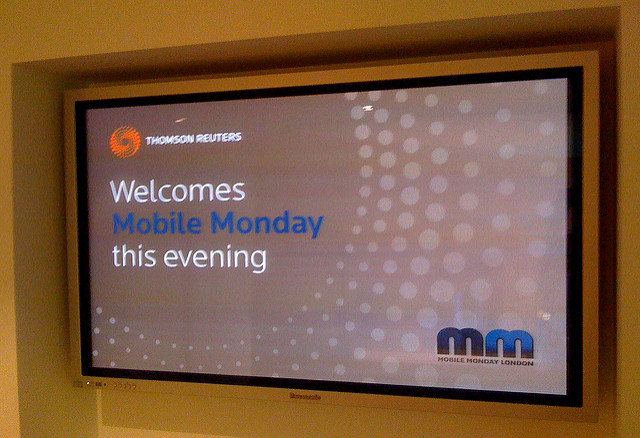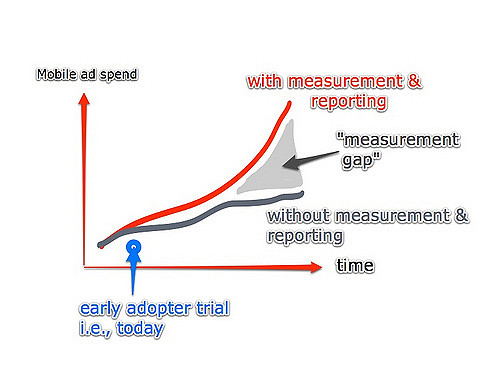
Last night I was at Mobile Monday London to catch four presentations. The topic: advertising on mobile. The summary: there’s a need for better measurement.
Claire Valoti from Mindshare was up first, giving the agency view of mobile advertising. She split the appeal of mobile in a media plan in to two parts: as a delivery mechanic (to extended reach, getting to a winder audience in a different mode); and as a platform (for couponing, or video uploads). She then went on to describe some issues and themes… and standardization and measurement were pretty much top of the list. That is, there’s currently no good standard measure of reach, sessions, traffic or users for mobile advertising. And even if there was, it needs to be integrated into existing web buying systems, rather than via a mobile-specific system.
Claire had a good observation on social networking, and the importance for mobile. The m:metrics numbers quoted showed that the 18-24 and 25-34 age groups were more likely to be using social networking from the mobile, compared to 13-17 age group. It’s not just about a youth market.
Another good point was made that events drive handset usage, as does “the right handset”. An example given: at the end of the football (soccer) season, there’s a drop in usage; during the season people are out and about and will use the mobile internet to look up news. As for “the right device”, just look at the figures for internet usage on the iPhone compared to anything else….
Obviously mobile advertising has to be used in the context of the whole campaign, and it has to be relevant content: don’t go taking an ad made for TV and slapping it on a mobile. Use the right techniques to get reach (banners, SMS, bluetooth), use location information to make it relevant, use coupons and free content to make it useful to the customer. And the user experience needs to be more streamlined: don’t issue mobile coupons without telling your retail staff how to handle them.
Aside from measurement, another barrier to growing advertising budgets is the number of people involved in setting up a mobile campaign. The buying experience needs to be more streamlined.
Mobile advertising challenges were summarized as: speed, reach, cost, ROI, standards, and measurement. As examples of reach issues: Claire was interested in QR codes, but only 10% of mobile devices have a reader installed; buying from Blyk or similar to get an audience was described as having “limited reach” at the moment; mobile search needs to scale up as, right now, it’s hard to spend the budget.
Shan Henderson from Vodafone kicked off his presentation by saying that it’s the metrics that matter. Click rate is not the full story, but it’s often the headline. Also audience demographic, behaviour, session length, frequency and reach are all important because “money follows measurement in media”. He showed the “measurement gap” graph. I’m sure the slides will be available soon, but for now I’ve done a shaky recreation:

(I’m guessing Edward Tufte would not approve). So, we all agree it seems: we need better standards for measurement and more efficency in the buying and selling of advertising in order for the market to grow.
To address this, Shan went on to describe the GSMA Metrics Study which aims to make it easy to plan and measure mobile media. Later this year it’s going to produce (one or more of): guidelines, best practices, definitions, technical standards, responsible ad practices, content standards. This will all be via an as yet unnamed ABC-like trusted independent organization.
Russell Buckley took the stage to talk about Admob, a self-serve and full-service ad network, shifting 2.bn ads a month, in 160 countries via 3000 mobile web sites. They select mobile sites, put ads on them, and share the revenue with the site. He described mobile advertising as good for: bands; to promote mobile websites; for operators to monetize their sites; and content owners to have access to a new marketing channel.
There was then a page of logos of who’s advertising, and it showed that the US is generally ahead in terms of adopting mobile advertising. In fact, ad requests by country (to March) showed 47% of ads were for the USA. Other figures were: India (9.8%); UK (6.7%); South Africa (5.3%); Indonesia (4.7%); Romania (1.9%); Canada (1.3%); Philippines (1.3%); France (1%); Israel (1%); RoW (20.1%). By handset, Nokia were the top, although they are dropping: something that’s not yet reflected in their market share.
Russell presented some case studies. MTV wanted to drive traffic to an awards site, and using text adverts they had a 300% traffic boost and 400% increase in downloads. Land Rover USA saw 23% of users interacting with an advertised landing page, with 3% going on to click the link to make a call to a dealer. Adidas saw a CTR of “well above 3%”. Coca-Cola saw a CTR of 1.31%, but 130% watched a mobile video that was being promoted (some people watched it more than once).
Ray Anderson from Bango described the basic model for using advertising as: select a channel, measure response, look at user purchases, analyse ROI, then… repeat.
He made some great observations on the issues of search. Depending on the combinations of search provider and operator, you may find you get very different results from the advertising spend (especially if the content is transcoded). But he had a graph that compared the revenue Bango customers had received over time from Orange and Vodafone: the doubling (or more) in the graphs when the operators introduced a search page was impressive.
After the talks there was a brief panel session. All good stuff. And held in a great building.
Photos: from Route79, from appelquist, from Alex Craxton
Video and audio: usual appear on the Mobile Monday web site after a little while, so check there.